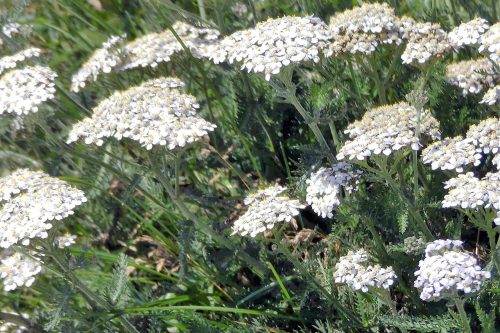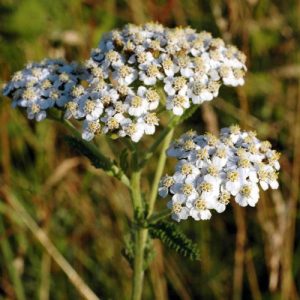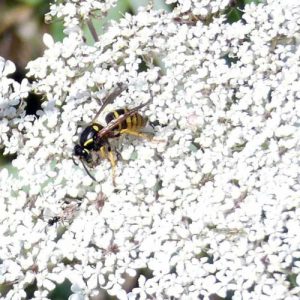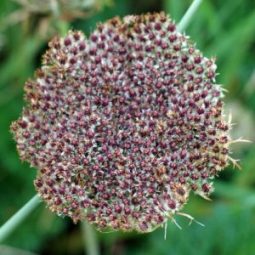Tags
achillea millefolium, meadow wildflowers, milddail, roadside wildflowers, wildflower essential oils, wildflower with white flowers, yarrow
Yarrow-Achillea millefolium, also known in English as woundwort; nosebleed plant; staunch grass; old man’s pepper; devil’s nettle, sanguinary; milfoil; soldier’s woundwort; thousand-leaf, and thousand-seal. In Welsh it is Milddail.
Yarrow is tough, a survivor in a wide variety of habitats, with a history of use by mankind culturally and medicinally reaching back to ancient times.
Flowering: (June) July to September
Habitat: Yarrow grows from sea level to 3,500 metres (11,500 ft) in elevation. It thrives throughout the British Isles in meadows and hedgerows, on road verges and wasteland and in sandy coastal places. Having deep, water-seeking tap roots, yarrow is able to resist drought and to persist on roadsides and verges that are mown: cutting blades are usually set high, resulting in only the flowers being lost while the rest of the plant remains to grow again. They also flower after the spring cut and by the time the autumn cut is made, most of the plants are seeding.
Description:
A plant native to Great Britain, Yarrow is a member of the Asteraceae (Daisy) family.
Yarrow is an upright, short to medium height, downy, strongly aromatic perennial plant. Stems are furrowed, stiff, unbranched and creeping. The flowers are 4-6mm across and arranged in clusters in flat-topped heads comprising yellowish disc florets and white to pink ray florets. The attractive feathery leaves are dark green and finely divided. Fruits are achenes.
- Flowers
- Achenes
THE PLANT NAME
The genus name, Achillea is said to have been attributed to the plant as Achilles, the legendary Greek warrior-hero, was said to have applied yarrow to heal wounds made by iron weapons in the Trojan War. The species name millefolium, meaning ‘thousand leaf’, refers to the plants numerous feathery leaves.The English name yarrow comes from the Old English word gearwe, which is related to both the Dutch word gerw and the Old High German word garawa.
IMPORTANCE TO INSECTS
Yarrow provides a rich source of nectar in late summer when many earlier wildflowers have finished flowering. It is particularly attractive to predatory wasps and hoverflies and is useful in gardens as a companion plant to attract these insects, which drink the nectar and then take insect pests as food for their larvae.
FOLKLORE & LEGEND
In East Anglia, as late as 1900, yarrow was credited with the power to avert spells and sickness if it was scattered on doorsteps and hung on cradles on Midsummer Eve. In the Fens, yarrow-stuffed cushions were a safeguarding household accessory. Similarly in Ireland, yarrow was held to drive away evil and sickness, but also as a potion that would not only increase physical attractiveness, but also protect people from being hurt by the opposite sex. In a Gaelic chant a woman says: ” I will pick the green yarrow that my figure may be fuller… that my voice will be sweeter… that my lips will be like the juice of the strawberry… I shall wound every man, but no man shall harm me.” In the Hebrides a leaf held against the eyes was believed to give second sight.
TRADITIONAL USES
In the Middle Ages, yarrow was part of an herbal mixture known as gruit used in the flavoring of beer prior to the use of hops. Yarrow has also been used as a food or in teas, and was very popular as a vegetable in the 17th century. The younger leaves are said to be a pleasant leaf vegetable when cooked like spinach, or in a soup. Yarrow is sweet with a slight bitter taste. The dried leaves can also be used as a flavouring herb in cooking.
MEDICINAL USES
A. millefolium has a well-documented historical use in traditional medicine, often because of its astringent effects. The herb is purported to be a diaphoretic (inducing sweating), astringent, tonic,]stimulant and mild aromatic. It contains isovaleric acid, salicylic acid, asparagin, sterols, flavonoids, bitters, tannins, and coumarins. This medicinal use is also reflected in some of the common names mentioned above, such as ‘staunchweed’ and ‘soldier’s woundwort’.
As with Achilles, in Great Britain the Anglo-Saxons also believed that the plant, which is sometimes also referred to as woundwort, would instantly cleanse and heal injuries made with sharp-edged tools. In this event it was pounded with grease and applied as an ointment or poultice. Another old name ‘nosebleed plant’ is a little confusing, some sources claim the fresh leaves will staunch a nosebleed, whilst others say it will cause a nosebleed, thus relieving a headache or ‘megrim’. In Suffolk an old rhyme says ‘Green yarrow, green yarrow, you bears a white blow, If my love loves me, my nose will bleed now!’
AROMATHERAPY
The dark blue essential oil, extracted by steam distillation of the flowers, has been traditionally used for a wide variety of complaints including fever, nervous tension and digestive problems and also as an anti-inflammatory and in chest rubs for colds and influenza. It is said to promote hair growth and as it has astringent properties, to tone skin. This oil also kills the larvae of the mosquito Aedes albopictus.







